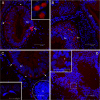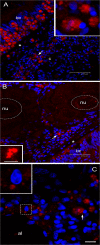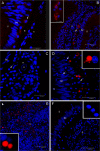The Expression of a Novel Mitochondrially-Encoded Gene in Gonadic Precursors May Drive Paternal Inheritance of Mitochondria
- PMID: 26339998
- PMCID: PMC4560408
- DOI: 10.1371/journal.pone.0137468
The Expression of a Novel Mitochondrially-Encoded Gene in Gonadic Precursors May Drive Paternal Inheritance of Mitochondria
Abstract
Mitochondria have an active role in germ line development, and their inheritance dynamics are relevant to this process. Recently, a novel protein (RPHM21) was shown to be encoded in sperm by the male-transmitted mtDNA of Ruditapes philippinarum, a species with Doubly Uniparental Inheritance (DUI) of mitochondria. In silico analyses suggested a viral origin of RPHM21, and we hypothesized that the endogenization of a viral element provided sperm mitochondria of R. philippinarum with the ability to invade male germ line, thus being transmitted to the progeny. In this work we investigated the dynamics of germ line development in relation to mitochondrial transcription and expression patterns using qPCR and specific antibodies targeting the germ line marker VASPH (R. philippinarum VASA homolog), and RPHM21. Based on the experimental results we conclude that both targets are localized in the primordial germ cells (PGCs) of males, but while VASPH is detected in all PGCs, RPHM21 appears to be expressed only in a subpopulation of them. Since it has been predicted that RPHM21 might have a role in cell proliferation and migration, we here suggest that PGCs expressing it might gain advantage over others and undertake spermatogenesis, accounting for RPHM21 presence in all spermatozoa. Understanding how foreign sequence endogenization and co-option can modify the biology of an organism is of particular importance to assess the impact of such events on evolution.
Conflict of interest statement
Figures










Similar articles
-
Doubly uniparental inheritance of mitochondria as a model system for studying germ line formation.PLoS One. 2011;6(11):e28194. doi: 10.1371/journal.pone.0028194. Epub 2011 Nov 29. PLoS One. 2011. PMID: 22140544 Free PMC article.
-
Paternally transmitted mitochondria express a new gene of potential viral origin.Genome Biol Evol. 2014 Feb;6(2):391-405. doi: 10.1093/gbe/evu021. Genome Biol Evol. 2014. PMID: 24500970 Free PMC article.
-
De Novo assembly of the Manila clam Ruditapes philippinarum transcriptome provides new insights into expression bias, mitochondrial doubly uniparental inheritance and sex determination.Mol Biol Evol. 2012 Feb;29(2):771-86. doi: 10.1093/molbev/msr248. Epub 2011 Oct 5. Mol Biol Evol. 2012. PMID: 21976711 Free PMC article.
-
The unusual system of doubly uniparental inheritance of mtDNA: isn't one enough?Trends Genet. 2007 Sep;23(9):465-74. doi: 10.1016/j.tig.2007.05.011. Epub 2007 Aug 6. Trends Genet. 2007. PMID: 17681397 Review.
-
Atypical mitochondrial inheritance patterns in eukaryotes.Genome. 2015 Oct;58(10):423-31. doi: 10.1139/gen-2015-0090. Epub 2015 Sep 14. Genome. 2015. PMID: 26501689 Review.
Cited by
-
In vitro detection of marine invertebrate stem cells: utilizing molecular and cellular biology techniques and exploring markers.Front Cell Dev Biol. 2024 Aug 22;12:1440091. doi: 10.3389/fcell.2024.1440091. eCollection 2024. Front Cell Dev Biol. 2024. PMID: 39239558 Free PMC article. Review.
-
Mitochondrial activity in gametes and uniparental inheritance: a comment on 'What can we infer about the origin of sex in early eukaryotes?'.Philos Trans R Soc Lond B Biol Sci. 2018 Mar 5;373(1741):20170147. doi: 10.1098/rstb.2017.0147. Philos Trans R Soc Lond B Biol Sci. 2018. PMID: 29335380 Free PMC article. No abstract available.
-
Mitochondrial membrane potential: a trait involved in organelle inheritance?Biol Lett. 2015 Oct;11(10):20150732. doi: 10.1098/rsbl.2015.0732. Biol Lett. 2015. PMID: 26490419 Free PMC article.
-
Deciphering the Link between Doubly Uniparental Inheritance of mtDNA and Sex Determination in Bivalves: Clues from Comparative Transcriptomics.Genome Biol Evol. 2018 Feb 1;10(2):577-590. doi: 10.1093/gbe/evy019. Genome Biol Evol. 2018. PMID: 29360964 Free PMC article.
-
Faraway, so close. The comparative method and the potential of non-model animals in mitochondrial research.Philos Trans R Soc Lond B Biol Sci. 2020 Jan 20;375(1790):20190186. doi: 10.1098/rstb.2019.0186. Epub 2019 Dec 2. Philos Trans R Soc Lond B Biol Sci. 2020. PMID: 31787048 Free PMC article.
References
-
- Extavour CG, Akam M. Mechanisms of germ cell specification across the metazoans: epigenesis and preformation. Development. 2003; 130: 5869ng (sp - PubMed
-
- Matova N, Cooley L. Comparative aspects of animal oogenesis. Dev Biol. 2001; 231: 291–320. - PubMed
-
- Kloc M, Bilinski S, Etkin LD. The Balbiani body and germ cell determinants: 150 years later. Curr Top Dev Biol. 2004; 59: 12003 - PubMed
-
- Reunov A. Structures related to the germ plasm in mouse. Zygote. 2006; 14: 231–238. - PubMed
-
- Parvinen M. The chromatoid body in spermatogenesis. Int J Androl. 2005; 28: 189238.r - PubMed
Publication types
MeSH terms
Substances
LinkOut - more resources
Full Text Sources
Other Literature Sources

